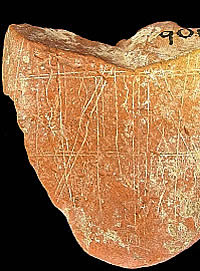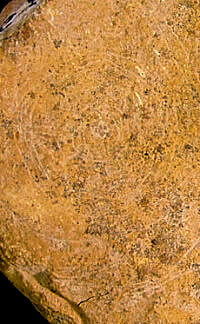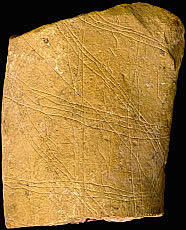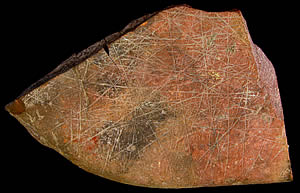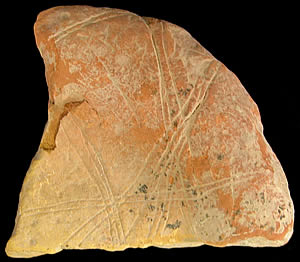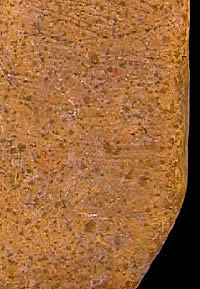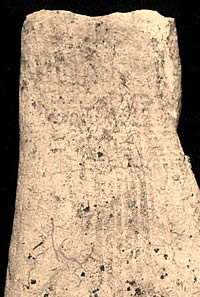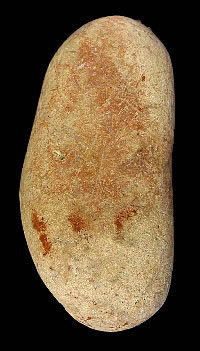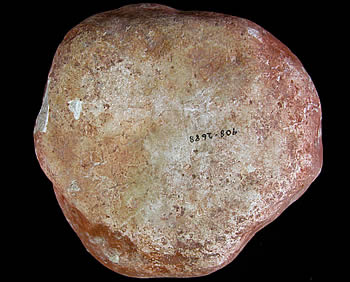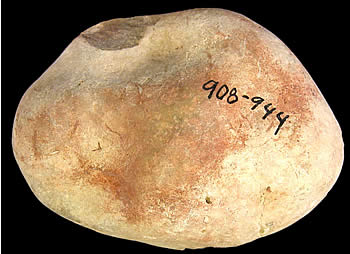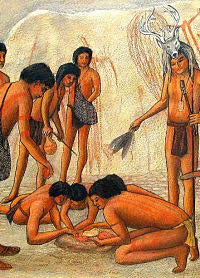
Young men gather around a vessel
of bright pigment in preparation for body painting in
this scene by artist Reeda Peel. In prehistoric times,
ocher pigment had many uses, whether for body adornment,
massive scenes on cave walls, or small painted pebbles—"portable
art." Although Kincaid Shelter had no preserved
wall art, investigators found decorated stones and evidence
of pigment production.
Click images to enlarge
|
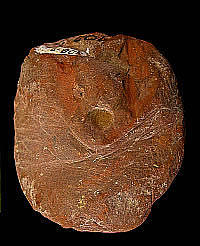
Cut marks and shallowly drilled holes
have created an animal-like face on this hard, red ocher
nodule, giving it the shape and appearance of a small
totem, or other special symbolic object. TARL Collections.
Click to enlarge and see reverse.
|
|
Ancient artisans were at work at Kincaid throughout
much of its history. They selected flat pebbles on which to
engrave intricate patterns and make odd scratchings—designs
that puzzle us today and cause us to ponder their meaning
and significance. Some of the work is finely executed with
parallel lines, grids, concentric circles, cross hatching,
and other geometric patterns.
Other designs—particularly the marks on
red and yellow ocher cobbles—appear more random, as if
someone scratched the surfaces repeatedly and from different
angles. Unlike the engraved objects, these "scratched"
stones likely were not "works of art," as we understand
the concept, but rather the "ingredients" of art.
Scratching ocher stone with a sharp tool or crushing small
ocher nodules produces a fine, pigment-rich powder that—with
a few added ingredients such as animal fat—becomes paint.
Working with a brilliantly hued palette of reds, oranges and
yellows, artists could paint designs on hides, small pebbles,
and cave walls, as well as bodies and faces.
There are other odd stones at Kincaid that apparently
were used for more practical purposes. Several large, flat
pebbles have random marks suggesting that rather than pigment
extraction, the stones were used as a hard surface for cutting
soft materials. And a number of curious, small, flat limestone
pebbles appear to be unmodified, devoid of any markings at
all. The stones are chiefly Edwards limestone, which does
not naturally occur in the shelter (Anacacho limestone formation).
Clearly, prehistoric workers gathered these small pebbles
from the river gravels and brought them into the shelter.
Were these blank "canvasses" stockpiled for future
artistry? Or were some once painted with special designs that
have faded away with time and weathering.
As you look at the various types of stones,
below, perhaps you will have your own ideas about their meaning
and significance. As will become evident, the stones cannot
be neatly classified; some clearly were used for one or more
different types of practical tasks, while others were more
esoteric and served purposes we cannot know. For a closer
look, images can be clicked on to view enlarged versions and,
in some cases, the reverse sides of artifacts. In some images,
contrast has been heightened to capture more detail.
Many of the engraved and scratched stones as
well as a quantity of the pigment stones from Kincaid were
found in Zone 5, a few were from Zone 6, but there were many
others found in disturbed fill, making it impossible to infer
a relative time period for their production. Based on information
from other sites, however, it appears that art in many forms
was significant to prehistoric peoples, from the Paleolithic
painters of the Old World to the most ancient Texans.
All of the specimens shown are curated in TARL
Collections, available for examination by qualified researchers.
Engraved Stones
|
|
In This Section:
|
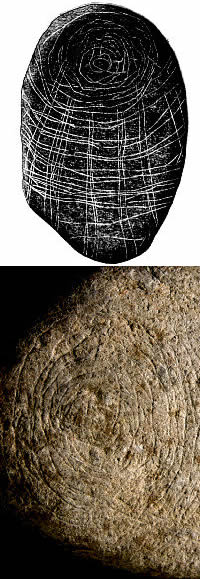
Like a medieval maze, the designs
on this palm-sized engraved stone form a tight spiral
of concentric circles. The pattern expands to a network
of rayed lines, as shown in the drawing above. This
motif, referred to as a spider-web pattern by some researchers,
appears on a number of both painted and engraved specimens
found in the dry shelters of the Lower Pecos region.
TARL Collections. Photo by Aaron Norment; drawing by
Hal Story. Click to enlarge photo.
|
|





